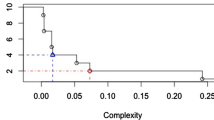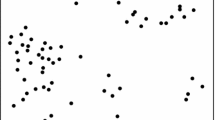Abstract
Distance-based methods use point-to-point distances or random-location-to-point distances in a cloud of points to estimate characteristics of the point pattern. One such characteristics is the density of points. The difficulty with distance-based density estimators is that their distribution depends on the spatial pattern of points. In particular, the distribution of distances is untractable for usual clustered patterns, that are often observed in natural systems. Here, we propose a density estimator for clustered patterns, based on the random-location-to-pth-point distance X p . An approximate expression for the distribution function, F p , of X p was obtained by identifying the first two moments of the count of individuals in disks for a given point process with the first two moments of a negative binomial distribution. The approximate expression of F p was then used to derive a maximum-likelihood estimator of the intensity of the point process. The quality of the approximation of F p was assessed for homogeneous Poisson processes (for which the expression of F p is exact) and for Matérn processes. The intensity estimator based on Matérn processes was then used to estimate tree density in a tree savanna in Mali, and it compared favorably with six robust estimators found in the literature.
Similar content being viewed by others
References
Abramowitz M, Stegun IA (1964) Handbook of mathematical functions (with formulas, graphs, and mathematical tables). US Government Printing Office, Washington
Brix A (1999). Generalized gamma measures and shot-noise Cox processes. Adv Appl Probab 31: 929–953
Brix A and Chadoeuf J (2002). Spatio-temporal modelling of weeds by shot-noise G Cox processes. Biom J 44: 83–99
Buckland ST, Anderson DR, Burnham KP and Laake JL (1993). Distance sampling: estimating abundance of biological populations. Chapman & Hall, London
Byth K (1982). On robust distance-based intensity estimators. Biometrics 38: 127–135
Clayton G and Cox TF (1986). Some robust density estimators for spatial point processes. Biometrics 42: 753–767
Cressie N (1991). Statistics for spatial data. John Wiley & Sons, New York
Diggle PJ (1975). Robust density estimation using distance methods. Biometrika 62: 39–48
Diggle PJ (1977). A note on robust density estimation for spatial point patterns. Biometrika 64: 91–95
Eberhardt LL (1967). Some developments in distance sampling. Biometrics 23: 207–216
Engeman RM, Sugihara RT, Pank LF and Dusenberry WE (1994). A comparison of plotless density estimators using Monte Carlo simulation. Ecology 75: 1769–1779
Fahrmeir L and Tutz G (2001). Multivariate statistical modelling based on generalized linear models, 2 edn. Springer-Verlag, Berlin, Germany
Holgate P (1964). The efficiency of nearest neighbour estimators. Biometrics 20: 647–649
Holgate P (1965). The distance from a random point to the nearest point of a closely packed lattice. Biometrika 52: 261–263
Howard CV and Reed MG (1998). Unbiased stereology: three-dimensional measurement in microscopy. BIOS Scientific Publishers, Oxford
Keuls M, Over HJ and Wit CT (1963). The distance method for estimating densities. Stat Neerl 17: 71–91
Lessard VC, Drummer TD, Reed DD (2002) Precision of density estimates from fixed-radius plots compared to n-tree distance sampling. For Sci 48:1–6
Lewis SM (1975). Robust estimation of density for a two-dimensional point process. Biometrika 62: 519–521
Martínez VJ and Saar E (2002). Statistics of the galaxy distribution. Chapman and Hall/CRC, Boca Raton
Møller J and Waagepetersen RP (2004). Statistical inference and simulation for spatial point processes. Chapman & Hall/CRC, Boca Raton
Moore PG (1954). Spacing in plant populations. Ecology 35: 222–227
Morisita M (1954). Estimation of population density by spacing method. Mem Fac Sci Kyushu Univ Ser E 1: 187–197
Nelder JA and Mead R (1965). A simplex algorithm for function minimization. Comput J 7: 308–313
Patil SA, Burnham KP and Kovner JL (1979). Non-parametric estimation of plant density by the distance method. Biometrics 35: 597–604
Patil SA, Kovner JL and Burnham KP (1982). Optimum non-parametric estimation of population density based on ordered distances. Biometrics 38: 243–248
Persson O (1964). Distance methods. The use of distance measurements in the estimation of seedling density and open space frequency. Stud Forestalia Suec 15: 1–68
Persson O (1971). The robustness of estimating density by distance measurements. In: Patil, GP, Pielou, EC and Waters, WE (eds) Statistical ecology: sampling and modeling biological populations and population dynamics., pp 175–190. Pennsylvania State University Press, University Park
Picard N, Kouyaté AM and Dessard H (2005). Tree density estimations using a distance method in mali savanna. For Sci 51: 7–18
Pollard JH (1971). On distance estimators of density in randomly distributed forests. Biometrics 27: 991–1002
R Development Core Team (2003) R: A language and environment for statistical computing. R Foundation for Statistical Computing, Vienna
Ramsey FL and Harrison K (2004). A closer look at detectability. Environ Ecol Stat 11: 73–84
Sheil D, Ducey MJ, Sidiyasa K and Samsoedin I (2003). A new type of sample unit for the efficient assessment of diverse tree communities in complex forest landscapes. J Trop For Sci 15: 117–135
Shiver BD and Borders BE (1996). Sampling techniques for forest ressource inventory. Wiley & Sons, New York
Stoyan D and Penttinen A (2000). Recent applications of point process methods in forestry statistics. Stat Sci 15: 61–78
Stoyan D and Stoyan H (1994). Fractals, random shapes and point fields. John Wiley & Sons, Chichester
Thompson HR (1956). Distribution of distance to nth neighbour in a population of randomly distributed individuals. Ecology 37: 391–394
Wolpert RL and Ickstadt K (1998). Poisson/gamma random field models for spatial statistics. Biometrika 85: 251–267
Author information
Authors and Affiliations
Corresponding author
Rights and permissions
About this article
Cite this article
Picard, N., Bar-Hen, A. Estimation of the density of a clustered point pattern using a distance method. Environ Ecol Stat 14, 341–353 (2007). https://doi.org/10.1007/s10651-007-0024-1
Received:
Revised:
Published:
Issue Date:
DOI: https://doi.org/10.1007/s10651-007-0024-1




